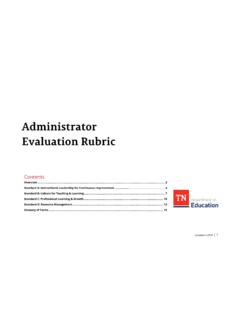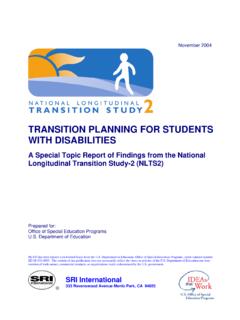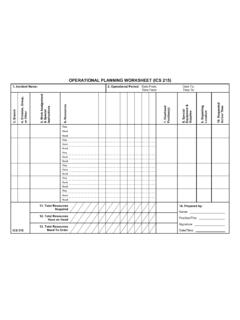Transcription of General Educator Rubric: Instruction - TEAM-TN
1 General Educator rubric : Instruction Significantly Above Expectations (5) At Expectations (3) Significantly Below Expectations (1). Standards and All learning objectives are clearly and explicitly Most learning objectives are communicated, Few learning objectives are communicated, Objectives communicated, connected to state standards and connected to state standards and referenced connected to state standards and referenced referenced throughout lesson. throughout lesson. throughout lesson. Sub-objectives are aligned and logically Sub-objectives are mostly aligned to the lesson's Sub-objectives are inconsistently aligned to the sequenced to the lesson's major objective. major objective. lesson's major objective. Learning objectives are: (a) consistently Learning objectives are connected to what Learning objectives are rarely connected to what connected to what students have previously students have previously learned. students have previously learned. learned, (b) know from life experiences, and (c) Expectations for student performance are clear.
2 Expectations for student performance are vague. integrated with other disciplines. There is evidence that most students There is evidence that few students demonstrate Expectations for student performance are clear, demonstrate mastery of the daily objective that mastery of the daily objective that supports demanding, and high. supports significant progress towards mastery of significant progress towards mastery of a There is evidence that most students a standard. standard. demonstrate mastery of the daily objective that supports significant progress towards mastery of a standard. Motivating The teacher consistently organizes the content so The teacher sometimes organizes the content so The teacher rarely organizes the content so that it Students that it is personally meaningful and relevant to that it is personally meaningful and relevant to is personally meaningful and relevant to students. students. students. The teacher rarely develops learning experiences The teacher consistently develops learning The teacher sometimes develops learning where inquiry, curiosity, and exploration are experiences where inquiry, curiosity, and experiences where inquiry, curiosity, and valued.
3 Exploration are valued. exploration are valued. The teacher rarely reinforces and rewards effort. The teacher regularly reinforces and rewards The teacher sometimes reinforces and rewards effort. effort. Presenting Presentation of content always includes: Presentation of content most of the time includes: Presentation of content rarely includes: Instructional visuals that establish the purpose of the lesson, visuals that establish the purpose of the lesson, visuals that establish the purpose of the lesson, Content preview the organization of the lesson, and preview the organization of the lesson, and preview the organization of the lesson, and include internal summaries of the lesson; include internal summaries of the lesson; include internal summaries of the lesson;. examples, illustrations, analogies, and labels for examples, illustrations, analogies, and labels for examples, illustrations, analogies, and labels for new concepts and ideas; new concepts and ideas; new concepts and ideas.
4 Effective modeling of thinking process by the modeling by the teacher to demonstrate modeling by the teacher to demonstrate teacher and/or students guided by the teacher to performance expectations; performance expectations;. demonstrate performance expectations; concise communication; concise communication;. concise communication; logical sequencing and segmenting; logical sequencing and segmenting;. logical sequencing and segmenting; all essential information; all essential information;. all essential information; no irrelevant, confusing, or non-essential no irrelevant, confusing, or non-essential no irrelevant, confusing, or non-essential information. information. information. Lesson Structure The lesson starts promptly. The lesson starts promptly. The lesson does not start promptly. and Pacing The lesson's structure is coherent, with a The lesson's structure is coherent, with a The lesson has a structure, but may be missing beginning, middle, and end. beginning, middle, and end.
5 Closure or introductory elements. 1. General Educator rubric : Instruction The lesson includes time for reflection. Pacing is appropriate and sometimes provides Pacing is appropriate for less than half of the Pacing is brisk and provides many opportunities opportunities for students who progress at students and rarely provides opportunities for for individual students who progress at different different learning rates. students who progress at different learning rates. learning rates. Routines for distributing materials are efficient. Routines for distributing materials are inefficient. Routines for distributing materials are seamless. Little instructional time is lost during transitions. Considerable time is lost during transitions. No instructional time is lost during transitions. Activities Activities and materials include all of the following: Activities and materials include most of the following: Activities and materials include few of the following: and Materials o support the lesson objectives; o support the lesson objectives; o support the lesson objectives.
6 O are challenging; o are challenging; o are challenging;. o sustain students' attention; o sustain students' attention; o sustain students' attention;. o elicit a variety of thinking; o elicit a variety of thinking; o elicit a variety of thinking;. o provide time for reflection; o provide time for reflection; o provide time for reflection;. o are relevant to students' lives; o are relevant to students' lives; o are relevant to students' lives;. o provide opportunities for student-to-student o provide opportunities for student-to-student o provide opportunities for student to student interaction; interaction; interaction;. o induce student curiosity and suspense; o induce student curiosity and suspense; o induce student curiosity and suspense;. o provide students with choices; o provide students with choices; o provide students with choices;. o incorporate multimedia and technology; and o incorporate multimedia and technology; and o incorporate multimedia and technology; and o incorporate resources beyond the school o incorporate resources beyond the school o incorporate resources beyond the school curriculum texts ( , teacher-made curriculum texts ( , teacher-made curriculum texts ( , teacher made materials, manipulatives, resources from materials, manipulatives, resources from materials, manipulatives, resources from museums, cultural centers, etc.)))
7 Museums, cultural centers, etc.). museums, etc.). In addition, sometimes activities are game-like, Texts and tasks are appropriately complex. involve simulations, require creating products, and demand self-direction and self-monitoring. The preponderance of activities demand complex thinking and analysis. Texts and tasks are appropriately complex. Questioning Teacher questions are varied and high-quality, Teacher questions are varied and high-quality Teacher questions are inconsistent in quality and providing a balanced mix of question types: providing for some, but not all, question types: include few question types: o knowledge and comprehension; o knowledge and comprehension; o knowledge and comprehension;. o application and analysis; and o application and analysis; and o application and analysis; and o creation and evaluation. o creation and evaluation. o creation and evaluation. Questions require students to regularly cite Questions usually require students to cite Questions are random and lack coherence.
8 Evidence throughout lesson. evidence A low frequency of questions is asked. Questions are consistently purposeful and Questions are usually purposeful and coherent. Questions are rarely sequenced with attention to coherent. A moderate frequency of questions asked. the instructional goals. A high frequency of questions is asked. Questions are sometimes sequenced with Questions rarely require active responses ( , Questions are consistently sequenced with attention to the instructional goals. whole class signaling, choral responses, or group attention to the instructional goals. Questions sometimes require active responses and individual answers). Questions regularly require active responses ( , ( , whole class signaling, choral responses, or Wait time is inconsistently provided. 2. General Educator rubric : Instruction whole class signaling, choral responses, written group and individual answers). The teacher mostly calls on volunteers and high- and shared responses, or group and individual Wait time is sometimes provided.)
9 Ability students. answers). The teacher calls on volunteers and non- Wait time (3-5 seconds) is consistently provided. volunteers, and a balance of students based on The teacher calls on volunteers and non- ability and sex. volunteers, and a balance of students based on When text is involved, majority of questions are ability and sex. text based Students generate questions that lead to further inquiry and self-directed learning. Questions regularly assess and advance student understanding When text is involved, majority of questions are text based Academic Oral and written feedback is consistently Oral and written feedback is mostly academically The quality and timeliness of feedback is Feedback academically focused, frequent, high-quality and focused, frequent, and mostly high-quality. inconsistent. references expectations Feedback is sometimes given during guided Feedback is rarely given during guided practice Feedback is frequently given during guided practice and homework review.
10 And homework review. practice and homework review. The teacher circulates during instructional The teacher circulates during instructional The teacher circulates to prompt student activities to support engagement, and monitor activities, but monitors mostly behavior. thinking, assess each student's progress, and student work. Feedback from students is rarely used to monitor provide individual feedback. Feedback from students is sometimes used to or adjust Instruction . Feedback from students is regularly used to monitor and adjust Instruction . monitor and adjust Instruction . Teacher engages students in giving specific and high-quality feedback to one another. Grouping The instructional grouping arrangements (either The instructional grouping arrangements (either The instructional grouping arrangements (either Students whole-class, small groups, pairs, individual; whole class, small groups, pairs, individual; whole-class, small groups, pairs, individual;. heterogeneous or homogenous ability) heterogeneous or homogenous ability) heterogeneous or homogenous ability) inhibit consistently maximize student understanding and adequately enhance student understanding and student understanding and learning efficiency.















